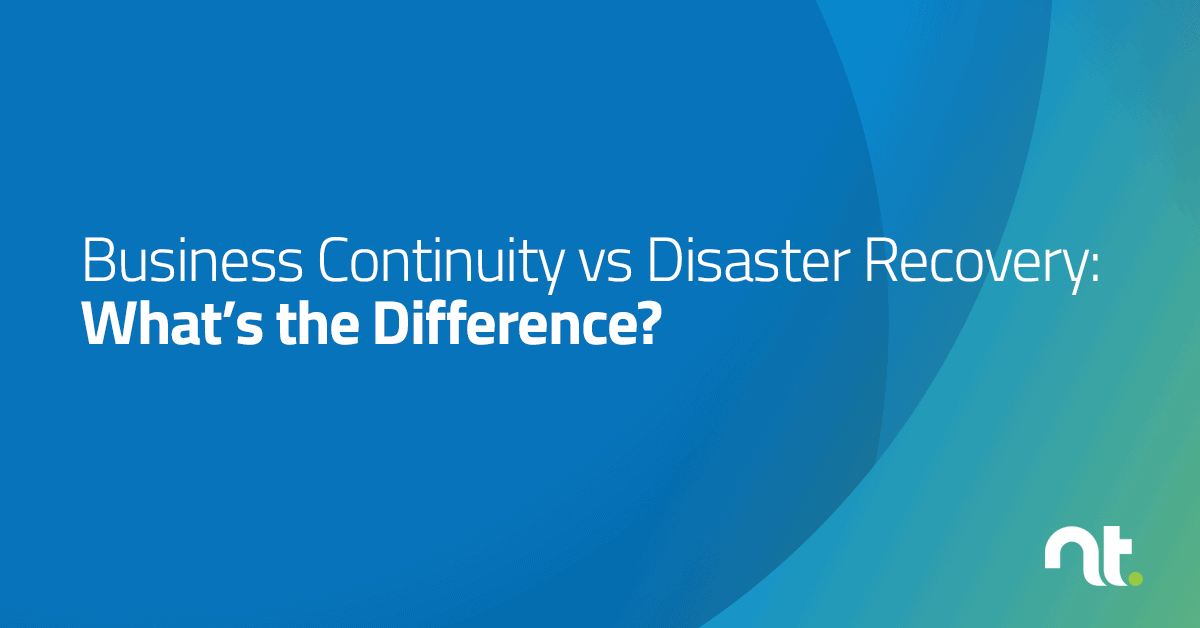- (Updated May 15, 2023)
Business Continuity vs Disaster Recovery: What’s the Difference?
When it comes to IT downtime, it’s not a matter of “if” but “when.” In fact, over the course of a 3-year period, 96% of businesses can expect to experience at least one IT systems outage1. Unexpected downtime can be caused by a variety of issues, such as power outages, weather emergencies, cyberattacks, software and equipment failures, pandemics, civil unrest, and human error.
Because downtime can vary in terms of root cause and severity, different incidents of downtime will exact different tolls. Any business operations that are dependent on IT—likely most of them—will be paralyzed until the root cause of the downtime can be rectified. For most small and medium-sized businesses (SMBs), this costs anywhere from $10,000 to $50,000 per hour2.
Depending on the cause of the downtime, it may also be accompanied by data loss or destruction. For example, ransomware attacks often involve a “double whammy” of IT systems downtime plus inaccessible data, which has been encrypted by the attackers. Ransomware attacks and disasters that result in permanent data destruction hit SMBs especially hard, and unfortunately, there are businesses that never recover.
With a business continuity plan and disaster recovery solutions, however, businesses can minimize their risk of experiencing downtime and data loss due to a disaster or other crisis event. The terms “business continuity plan” and “disaster recovery” are often used interchangeably, but they do represent distinct processes and solutions. The following sections clarify what these terms mean and how they work together to form a cohesive strategy:
What Is a Business Continuity Plan?
A business continuity plan is a set of processes, programs, supporting policies, techniques, guidelines, and procedures used to help an organization continue running during a disaster. They ensure a firm can continue functioning without downtime, regardless of adverse circumstances or events. Business continuity planning may include measures such as establishing redundant infrastructure, establishing backup management procedures, and creating guidelines for employee conduct during an adverse event. Most organizations have their business continuity plan written, kept under “lock and key,” and distributed amongst their senior leadership. Only certain members of leadership have the authority to initiate the business continuity plan, and it is regarded with the utmost seriousness if it is enacted.
What Is a Disaster Recovery Plan?
Normally included within a business continuity plan, the elements of a disaster recovery plan include the required steps and enabled technologies for recovering from a disruptive event. Disaster recovery commonly focuses on restoring data and IT system functionality immediately following a crisis event like disaster or cyberattack. Included in the plan is a list of all disaster recovery technology to be deployed and the owners of each deployment when applicable. This may include on-premises as well as off-site replication to ensure redundancy. There are many solutions that also allow for an entire technology environment to be “spun up” in the cloud—referred to as failover—in the case of an onsite disaster.
How Do They Work Together?
The business continuity plan is all-encompassing with the necessary steps for a business to respond to and recover from an unexpected incident or peril. The disaster recovery plan is a component of the broader business continuity plan and is the “mitigate” and “recover” portion of the plan. To put it simply: business continuity planning provides the blueprint to help you maintain “business as usual” with processes and procedures, while disaster recovery planning focuses on the tools and solutions required for restoring your compromised technology and data.
Do You Need One, or Both?
Now that you know the difference between the two and understand how they work together, the answer becomes very clear…you need both. If you have a business continuity plan, but no disaster recovery element to your plan, your efforts to restore normal functioning of your infrastructure may be disorganized and chaotic due to a lack of clear procedures. Even worse, if you have not taken measures to protect data from loss or destruction through careful backup planning, you may find yourself unable to restore some or all of your data.
Now let’s flip the scenario. Imagine that you have a disaster recovery strategy in place without a broader business continuity plan. In this case, you may have technology deployed that can be used to restore business-critical functions and data. But without the context of the business continuity plan, your employees may not know how to continue to be productive and serve your customers until the fix is implemented. In a high-stress situation such as a cyber incident or disaster, employees need clear instructions to follow until the situation is resolved. Without a business continuity plan, you can’t proactively manage your teams to make sure your organization can maintain critical operations and ultimately recover in the event of a disaster.
NexusTek Business Continuity and Disaster Recovery Planning
We offer complete business continuity planning services, as well as products designed and customized to ensure data and applications are fully restored and running when problems arise. Our disaster recovery services help protect your key business data while maintaining productivity and limiting financial losses during an outage. Our planning steps include:
- Evaluation & Consultation: NexusTek will evaluate the strengths and weaknesses of a company’s systems, its areas of vulnerability and possible threats, and identify other areas of potential risk.
- Plan Design: Based on our evaluation, NexusTek will design a business continuity and data disaster recovery plan that will be optimized for your company.
- Implementation & Testing: NexusTek will implement the plan, and formalize an ongoing testing and validation process to ensure your business continuity plans adapt to the company’s needs over time.
- Gill, M. (2023, February 9). 14 shocking data loss and disaster recovery statistics. Comparitech. https://www.comparitech.com/data-recovery-software/disaster-recovery-data-loss-statistics/
- Infrascale. (2020, May 13). Infrascale survey highlights the heavy costs of business downtime. https://www.infrascale.com/press-release/infrascale-survey-highlights-the-heavy-costs-of-business-downtime/
